
The Arts and Letters Club of Toronto Foundation's Award for Architectural Conservation
Canada Green Building Council Scholarship for Sustainable Design and Research
College of Fellows Centennial Fund for Intern/Intern Architect
Kiyoshi Matsuzaki RAIC RAIC Endowment Fund and Scholarship
RAIC Foundation Bursary
Vince Catalli Scholarship for Sustainable Architectural Innovation
ARTS & LETTERS CLUB OF TORONTO FOUNDATION AWARD FOR ARCHITECTURAL CONSERVATION
This award, which was given for the first time in 2022, recognizes emerging heritage conservation practitioners and celebrates excellence, innovation, and best practices in the applied field of architectural conservation while supporting an understanding of Canada’s built heritage.
Jury:
John Blumenson, Columnist Toronto Star; Julia Gersovitz, Trustee RAIC Foundation Allan Teramura, Watson MacEwen Teramura Architects
Winner:
Erin Haliburton, Dalhousie University:
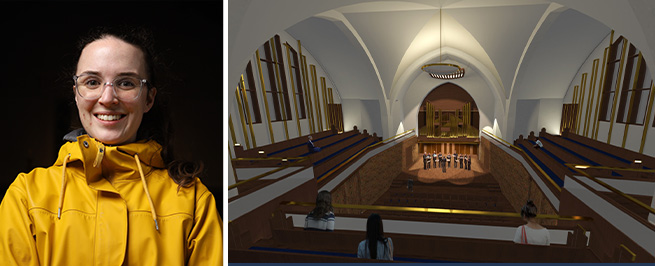
Abstract:
‘Informed by the historic Intersection of choral Music, church architecture, and acoustics,
My thesis will include the concept design of the adaptive reuse of a decommissioned church in Halifax, turning it into a concert hall catered especially towards the performance of choral music. Retrofitting concert halls into decommissioned churches is a suitable use of these buildings, as they maintain churches as sites of community gathering and capitalise off of the existing bonds between church architecture and music.’
Jury Comment:
The jury appreciated Erin’s application of her knowledge of choral music to the real-world, immediate problem of what to do with places of worship that can no longer be supported by their congregations. Her proposal to work with acousticians to study the physical properties of historic churches to better understand how they can enhance our experience of music also promises to expand our knowledge of how we appreciate historic places in general. We don’t listen to buildings enough, and the relationship between acoustics and conservation is one that deserves further investigation. Erin’s work shows great promise as a contribution to that effort.
Honourable Mention: *
Paloma Castonguay-Rufino, Université de Montréal
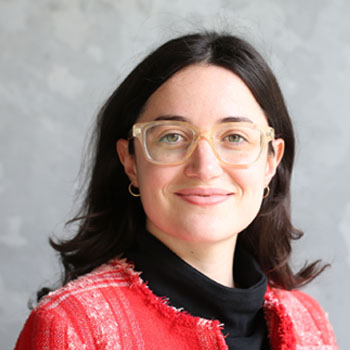
Abstract:
‘How to assess the architectural quality of industrial heritage? This doctoral research project in architecture at Université de Montréal examines the issues raised by the architectural project in the context of Canada's industrial heritage. This reflection is part of a broader tension between projects in heritage buildings and architectural conservation. Rehabilitation through architectural design is the hypothesis advanced here. This research proposes a method for objectifying the heritage value of industrial heritage in the Canadian context, based on the principle of exemplarity of built projects.’
*Note: Julia Gersovitz did not participate in this selection due to a conflict of interest.
Jury Comment:
Paloma’s project to study European practices in the rehabilitation of derelict industrial sites, and their potential application in the Canadian context, is a focused and well-developed proposal. Under-recognized as cultural artifacts, industrial structures seldom enjoy protection from heritage policy and yet they are durable and often arresting buildings. From both a cultural and sustainability perspective, examining international best practices for their adaptive reuse is a potentially valuable contribution to the discipline.
CAGBC SCHOLARSHIP FOR SUSTAINABLE DESIGN & RESEARCH
Established through an endowment from the Canada Green Building Council (CaGBC) the main purpose of the fund is to nurture the next generation of “green” designers. The award is made to the student or students with the best Master’s thesis proposal.
Jury:
Jonathan Bisson, RAIC President Elect; Joanne McCallum, McCallum Sather Architects; Vedran Skopac, Reimagine Architects
Winner:
Madeleine Lachance, McGill University

Abstract:
‘Most of the spaces we will be occupying in 2030 are those already built, and yet much of our existing housing stock was not designed to support the changing user needs of our diversely abled population or our changing climate. How can we work towards making our built environment? more accessible and sustainable, while acknowledging the material and financial costs of construction? The solution is to develop strategies for retrofit that will preserve the strong ‘bones’ or structures of our buildings while facilitating the changing of their ‘skins’ so they can better adapt to our evolving world. This project will look at a multi-unit residential typology in the Québec context and develop a strategy for its retrofit that would optimize it for current and future accessibility and sustainability needs.’
Jury Comment:
With its focus on multi-unit social housing, this is a very low-key proposal with a potentially profound impact; spreading the benefits of architecture across a broad spectrum of society.
The approach is nimble; promising significant improvements in spatial quality and building performance through modest interventions in existing public housing projects. In so doing, it shifts the conversation from the iconic to the everyday; focusing on what, from a social perspective, is arguably our most important building typology.
Another important aspect of the proposal is the idea of unfinished architecture that actively engages the building users in the creation and evolution of their built environment. Precedent projects by Elemental in Chile and Lacaton & Vassal in France, affirm the inherent beauty and potential outcomes of this design approach. Embracing uncertainty is part of its appeal.
COLLEGE OF FELLOWS CENTENNIAL FUND FOR INTERNS/ INTERN ARCHITECTS
The College of Fellows Centennial Fund for Interns or Intern Architects was created with donations received from Members of the College of Fellows and Members of the Royal Architectural Institute of Canada to support a deserving Intern or Intern Architect or group of Interns/Intern Architects wishing to promote the value and image of the profession.
Jury:
Paule Boutin, Treasurer RAIC Foundation; Dave Edwards, Trustee RAIC Foundation, Stuart Howard, Chair RAIC Foundation
Winner:
Salam Yousef, Intern Architect

Abstract:
‘Previous research in the areas of neuroscience and architecture opened my mind to the mysterious world of neurodiversity. I discovered that the term ‘autism’ covers a spectrum of many unique situations, and some people might not know that they are part of this spectrum. Neurological and developmental conditions influence how we experience the world through our social, physical, and mental interactions.
So, how do we celebrate this beautiful otherness in each one of us? This research will focus on how to create a collaboration between neuroscience and architecture to enhance the physical, mental, and social wellbeing of neuro-diverse individuals.’
Jury Comment:
The Jury was impressed with all the submissions received. The submission from Salam Yousef “Sensational Odyssey” stood out as most meeting the terms of reference. Ms. Yousef’s unorthodox road to internship appears to have led to her deeply rooted passion for Architecture and the potential for promotion of well-being through design. The jury felt that her development of the well-being of others, was in fact, the promotion of Architecture. Her submission was well thought out, clear, and communicated her passion for architecture and others.
KIYOSHI MATSUZAKI RAIC ENDOWMENT FUND AND SCHOLARSHIP
The endowment fund for this scholarship was established in honour of Kiyoshi Matsuzaki. This award given to a student enrolled in the RAIC Syllabus Program, recognizes the most deserving based upon academic achievement, studio and work experience, and financial need.
Jury:
Arlene Dedier, Trustee RAIC Foundation; Stuart Howard, Chair RAIC Foundation; Ivan Martinovic, Director RAIC Syllabus Program; Eva Matsuzaki, Matsuzaki Architects; Diarmuid Nash, Trustee RAIC Foundation; Jason Robbins, President RAIC
Winner:
Zainab Naji, British Columbia

Jury Comment:
There were multiple great submissions and a robust deliberation amongst the jurors. The awardee proved to be exceptional, with an outstanding submission amongst the syllabus students. It is hoped that this award will make a foundational difference in Zainab’s life and her mission to become an architect. Zainab’s journey from her country of birth to Canada demonstrates her pure determination and a wonderful commitment to architecture. She stands as a role model and an inspirational representative of the future of the syllabus program and represents the true spirit of the scholarship.
RAIC FOUNDATION BURSARY
The RAIC Foundation bursary has been established for a project that relates to architecture in its broadest sense, that encourages public education, or that makes possible significant scholarly research that results in publications, exhibitions, symposia, lectures, and/or conferences.
Jury:
Paule Boutin, Treasurer RAIC Foundation; Stuart Howard, Chair RAIC Foundation; Susan Ruptash, Chancellor RAIC College of Fellows
Winners:
Samuel Bernier-Lavigne and Ariane Ouellet-Pelletier, Université de Laval
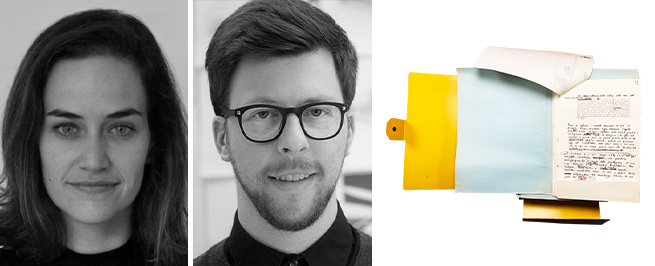
Abstract:
‘In society, architecture isn’t solely about building buildings but also about building ideas. This project aims to shed light on the intellectual – often invisible – structures holding our built environments up. More particularly, it focuses on documenting the contribution of prominent architectural theorist Georges Teyssot who, over a 50-year career contributed to the elevation of the construction of ideas around the practice of architecture in Canada. Throughout this period, he has curated multiple exhibitions, written 7 books, over 60 articles and contributions and has lectured extensively around the globe. In that sense, Québec has been at the epicentre of a vibrant international resonance in contemporary theories in architecture.’
Jury Comment:
The jury felt that the ‘Relevé intellectuel de Georges Teyssot (Publication + Exhibition + Symposium) project aligned perfectly with the objective of supporting academic research resulting in publications, exhibitions, symposia and conferences.
Several researchers, based at various universities in America and Europe, who have collaborated with Georges Teyssot, professor of architectural theory, over the last few decades, will participate in the writing of the publication presenting an analysis of the content, classification system and organization of Teyssot's library and research archive. The jury sees this as a testament to the value of his intellectual work in the eyes of the academic world, and is confident that the dissemination of his thought through the planned publication, exhibition and symposium will contribute to the development of research in the field of architectural theory.
VINCE CATALLI SCHOLARSHIP FOR SUSTAINABLE ARCHITECTURAL INNOVATION
This scholarship was endowed through a generous donation from Vince Catalli and is being awarded for the first time this year. The intent of this student award is to promote and encourage innovative, practical scalable and transferable approaches to sustainable design among the next generation of architects in Canada.
Jury:
Roxanne Gautier, EVOQ Architecture; Ron Kato, Kato Martin Architects; Diarmuid Nash, Trustee RAIC Foundation; Susan Ruptash, Chancellor RAIC College of Fellows
Winner:
Brett Walter, Laurentian University
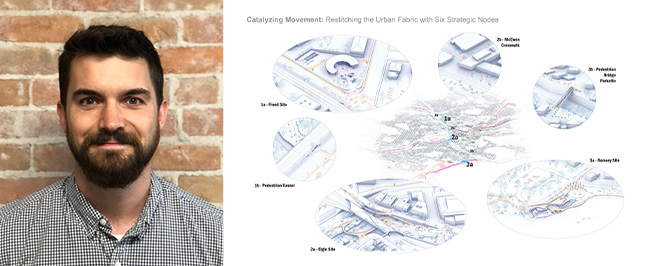
Abstract
New research in neuroscience, environmental psychology, and medicine have revealed factors in the built environment that improve health, however, these are not yet widely understood or adopted by the design community. A novel approach that better leverages the scientific literature to inform design is required. Recent discoveries in epigenetics reveal the immense impact our environment has on intergenerational human health through the process of epigenomic editing.
This thesis argues that design and health are inextricably linked to bioethical questions that require deeper exploration and ought to compel designers to reframe their role and responsibility in public health.
Jury Comment:
A really engaging introduction to and overview of the positive epigenetic potential of healthy activity and how this might be applied to design. The factor that elevates the project above and beyond the conceptual is that the author has also developed his socially driven mission to help the profession understand the ramifications of this research.
The project promotes the creation of more sustainable buildings, infrastructure and communities which stimulate healthy lifestyle changes and reduce carbon footprint. The author’s commitment to disseminate the knowledge gained to a broader public is exemplary; offering the prospect that these concepts could become recognized as foundational health drivers in design.
Honourable Mention
Larissa Korol, Dalhousie University
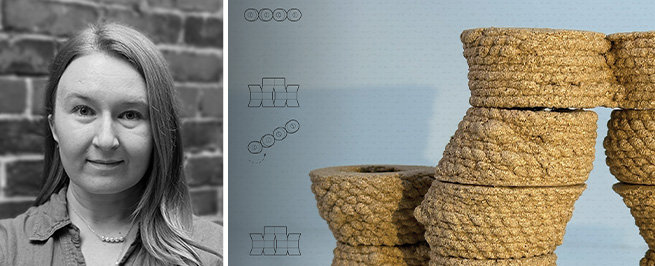
Abstract:
This thesis combines bio-based materials, computational design, and digital fabrication to generate and test architectural demonstrators made from agricultural residues. More specifically, this thesis uses the by-products of a local fiber flax production, with parameter based generative algorithm scripts and additive manufacturing (AM), more commonly known as extrusion 3D printing. The interest in this research comes from an optimistic belief that architectural materials can move away from carbon intensive, unsustainable extractive practices and towards bio-based materials in circular ecologies.
Jury Comment:
This submission demonstrates a rigorous and holistic approach in exploring the potential use of locally grown flax by-products for architectural applications. The submission is clearly presented and explores methodically the potential use for an agricultural by-product - that would otherwise be discarded and wasted - to create bio-based materials for the architectural and construction industries.
If our society can develop new bio-based building materials through this kind of research, combined with emerging fabrication technologies, this would revolutionize how we design & build, and eliminate a significant portion of waste and emissions. The iterative process described by the author provided insight into the challenges and potentials of the use of new materials.



